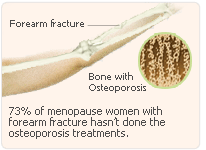
Bone fractures become more an more common as women age, undoubtedly due to the weakening of the bones as estrogen levels fall and the common onset of osteoporosis as a result. Unfortunately the painful and inconvenient aspects of such post menopausal fractures are hard to avoid for women who have developed osteoporosis, as a fracture can commonly be attained simply from falling from an upright position. Estrogen therapy, has up to now been a good treatment for this condition as the added estrogen helps to strengthen bones however the other health implications of estrogen therapy been that this treatment is becoming less of a long term option for many women. The risks of breast cancer and heart disease are turning women away from the use of estrogen therapy and for this reason such women do not get the benefits of this treatment either.
A recent study conducted in Minnesota has looked into the ways in which osteoporosis can be treated and the reasons why this treatment is not given to so many post menopausal women who could benefit from it. The study followed a population-based retrospective cohort of female patients who were over the age of 45. A review of the women's medical records was undertaken for those subjects who had suffered a for arm fracture due to osteoporosis from 1995 to 1997. The 343 women who took part in this study had an average age of 70 and the results show the types of treatments they received as a result of their fractures.
estrogen forearm

Out of the 343 women who finished the study 83% of them had seen a non-specialist orthopedic doctor in the following 12 months after their fracture. Out of this group, 17% went on to receive treatment for osteoporosis. Interestingly treatment was more likely to be offered to those women who had already been diagnosed as suffering from osteoporosis in the past, those who had suffered multiple fractures in the past or those that were long term smokers. This left 72% of women without any suggested treatment for osteoporosis even after a forearm fracture and the team of researchers undertaking this study were shocked that more wasn't done to utilize the treatments available for osteoporosis.
The results of this study demonstrate that osteoporosis treatment could be very effective in preventing further fractures in those menopausal women who have already suffered from fractures in the past. The role of estrogen therapy may have been a factor in the limited use of this type of treatment in the past, but the increasing evidence for ill side effects associated with estrogen therapy may mean that as more women chose to use estrogen therapy only in the short term, an effective osteoporosis treatment can be used instead to counter fractures.